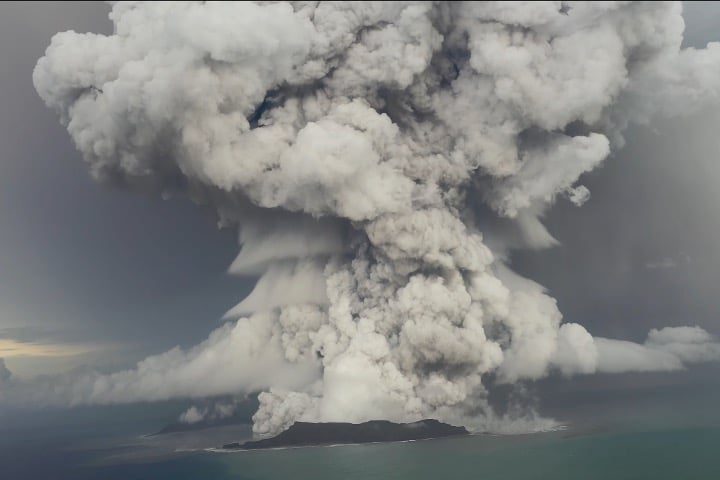
Lost in all the hysterical proclamations of “historic” summer heat waves and “hottest day ever” proclamations this summer is a theory that H2O, not CO2 and other trace atmospheric gases, may be driving hotter-than-normal temperatures. Both NASA and the European Space Agency seemingly endorse the notion that a gigantic undersea volcano that erupted from December 2021 until mid-January 2022 may have spurred a dramatic increase in water vapor — the Earth’s main greenhouse gas — contributing to higher air temperatures this year.
When the Hunga Tonga-Hunga Ha’apai volcano erupted, it reportedly spewed a stupendous amount of H2O as water vapor into the atmosphere, enough, it is said, to have filled no less than 58,000 Olympic-size swimming pools.
“The violent Hunga Tonga-Hunga Ha’apai eruption on 15 January 2022 not only injected ash into the stratosphere but also large amounts of water vapor, breaking all records for direct injection of water vapor, by a volcano or otherwise, in the satellite era,” a study published in Geophysical Research Letters reported.
According to the study, this one event added the equivalent of an additional 10 percent of the normal amount of water vapor into the atmosphere.
“The massive blast injected water vapor up to altitudes as high as 53 km. Using measurements from the Microwave Limb Sounder on NASA’s Aura satellite, we estimate that the excess water vapor is equivalent to around 10% of the amount of water vapor typically residing in the stratosphere. Unlike previous strong eruptions, this event may not cool the surface, but rather it could potentially warm the surface due to the excess water vapor,” the study stated.
“We’ve never seen anything like it,” said Luis Millán, a scientist at NASA’s Jet Propulsion Laboratory and a lead author of the study. “We had to carefully inspect all the measurements in the plume to make sure they were trustworthy.”
A more recent study, published in Nature, claimed that the amount of excess water vapor in the atmosphere was even higher.
“From a combination of various types of satellite and ground-based observations supported by transport modeling, we show evidence for an unprecedented increase in the global stratospheric water mass by 13 percent relative to climatological levels, and a 5-fold increase of stratospheric aerosol load, the highest in the last three decades.”
Volcanic eruptions of the past have generally resulted in a cooling effect due to ash blocking the sun to some extent — the 1815 eruption of Mount Tambora in Indonesia, for example, is thought to be largely responsible for the historical “Year Without Summer.” However the underwater nature of this event — over 400 ft. under the surface — led to a muted ash cloud but a much more prominent cloud of water vapor, which is the Earth’s most plentiful and most potent greenhouse gas.
Some experts are saying that the sheer amount of water vapor released by the Tonga volcano could remain in the stratosphere for several years, possibly contributing to warmer summers in years beyond 2023.
Additionally, there are other factors — not man-made — that may be contributing to warmer-than-normal summer days. For instance, NOAA’s Space Weather Prediction Center shows that the sun is nearing the peak of solar activity in its 11-year cycle, with the peak activity expected in 2025.
Another factor is that the Pacific Ocean appears to be entering an El Nino phase, which generally means that warmer tropical wind patterns lead to more balmy conditions, particularly in the southern United States.
So, why is it that anthropogenic climate change is garnering all the headlines in conjunction with the warm weather being experienced this summer? Why are these other factors rarely, if ever, mentioned when the topic of summer heat is brought up by news anchors and climate-change-invested politicians?
The reason is obvious. These crystal-clear and much more potent factors in global temperature cannot be blamed on man — they’re entirely natural. The narrative that man alone is causing an increase in temperature is too important to be challenged scientifically.
Mankind’s effect on weather is dwarfed by the Earth’s natural drivers of climate. But to hear the propaganda being spouted by climate hysterics, everyone who drives a gas-powered vehicle is personally responsible for the heat waves we experience in summer.
When you consider these natural factors, pronouncements such as UN Secretary-General António Guterres’ declaration that “the era of global boiling has arrived” ring somewhat hollow. It’s much more politically expedient to be able to blame mankind for the weather.
Related article:




